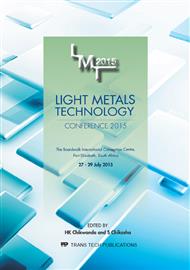[1]
A.M. Lewis, J.C. Kelly, G.A. Keoleian, Vehicle light-weighting vs. Electrification. Life cycle energy and GHG emissions results for diverse powertrain vehicles, J. App Energy 126 (2014) 13-20.
DOI: 10.1016/j.apenergy.2014.03.023
Google Scholar
[2]
A.R. Mayyas, Q. Shen, A.T. Mayyas, M. Abdelhamid, D. Shan, A. Qattawi, Using quality function deployment and analytical hierarchy process for material selection of body-in-white, J. Materials & Design 32 (2011) 2771-3278.
DOI: 10.1016/j.matdes.2011.01.001
Google Scholar
[3]
G. Belingardi, J. Obradović, Recent developments in car body lightweight design: A contribution toward greener environment, J. Mobility & Vehicle Mechanics, 38 (2012) (4).
Google Scholar
[4]
N. Lutsey, Review of technical literature and trends related to automobile mass reduction technology, California Air Resources Board (2010), UCD-ITS-RR-10-10.
Google Scholar
[5]
Information on http: /www. aluminum. org/auto/truck/Handling and Performance/ (Aluminium Association, Auto/Truck - Handling and Performance (2008). Accessed on July 10, 2014).
Google Scholar
[6]
Information on http: /www. alueurope. eu/pdf/Aluminium_in_cars_Sept2008. pdf (European Aluminium Association, Aluminium in cars, EAA Brochure, Brussels (2007). Accessed: 10/08/(2014).
Google Scholar
[7]
A. Mayyas, A. Qattawi, M. Omar, D. Shan, Design for sustainability in automotive industry: A comprehensive review, Renewable and Sustainable Energy Reviews, 16 (2012) 1845-1862.
DOI: 10.1016/j.rser.2012.01.012
Google Scholar
[8]
M.K. Surappa, Aluminium matrix composites: challenges and opportunities, Sādhanā. Vol. 28, Parts 1 & 2, February/April 2003, pp.319-334.
Google Scholar
[9]
D. Andress, S. Das, F. Joseck, T.D. Nguyen, Status of advanced light-duty transportation technologies in the US, J. Energy Policy 41 (2012) 348-364.
DOI: 10.1016/j.enpol.2011.10.056
Google Scholar
[10]
J. Simpson, Aluminum advances: aluminum passes iron among automotive materials in use worldwide; what lies ahead? Aluminum Industry Report, (2007).
Google Scholar
[11]
A. Macke, B.F. Schultz, P. Rohatgi, Metal Matrix Composites - Offer the Automotive Industry an Opportunity to Reduce Vehicle Weight, Improve Performance, J. Advanced Materials & Processes, (2012) 19-23.
DOI: 10.31399/asm.amp.2012-03.p019
Google Scholar
[12]
C.H. Caceres, Economical and Environmental Factors in Light Alloys: Automotive Applications, J. Metallurgical and Material Transactions A, Volume 38(A) (2007) 1649-1662.
DOI: 10.1007/s11661-007-9156-z
Google Scholar
[13]
D. Keith, HSS, AHSS and aluminum jockey for position in the race to cut auto curb weight, American Metal Market Monthly, February 1, (2010).
Google Scholar
[14]
G. Withers, P.D.W. Tilakaratna, Performance evaluation of ULTALITE® low cost aluminum metal matrix composite based brake drums, SAE Technical Paper 2005-01-3936 (2005).
DOI: 10.4271/2005-01-3936
Google Scholar
[15]
W. Maddever, S. Guinehut, Use of Aluminum Foam to Increase Crash Box Efficiency (2005), SAE Technical Paper 2005-01-0704.
DOI: 10.4271/2005-01-0704
Google Scholar
[16]
E. Ghassemieh, Materials in Automotive Application, State of the Art and Prospects, in: M. Chiaberge (Ed. ), New Trends and Developments in Automotive Industry (2011), InTech, ISBN 978-953-307-999-8.
DOI: 10.5772/13286
Google Scholar
[17]
D. Richman, Lighter and Safer Cars by Design, The Aluminum Association Transportation Group (ATG) and NHTSA Mass/Size/Safety Workshop, May 13 (2013), Washington, D. C.
Google Scholar
[18]
D. Lavrinc, Audi aluminum-bodied A5 prototype sheds over 240 lbs 92009). Information on http: /www. autoblog. com/2009/09/30/audi-aluminum-bodied-a5-prototype-sheds-over-240-pounds/. Accessed June 15, (2014).
Google Scholar
[19]
Y. Komatsu, K. Ban, T. Ito, Y. Muraoka, T. Yahaba, K. Yasunaga, M. Shiokawa, Application of All Aluminum Automotive Body for HONDA NSX. SAE Technical Paper (1991) 910548.
DOI: 10.4271/910548
Google Scholar
[20]
Y. Muraoka, H. Miyaoka,. Development of an all-aluminum automotive body. J. Materials Processing Technology 38 (1993) 655-674.
DOI: 10.1016/0924-0136(93)90042-5
Google Scholar
[21]
S. Birch, Jaguar remakes XJ, Information on http: /www. sae. org/mags/sve/7547. SAE International Publications (2010). Accessed July 8, (2014).
Google Scholar
[22]
Lotus Engineering, Inc., An Assessment of Mass Reduction Opportunities for a 2017-2020 Model Year Vehicle Program (2010).
Google Scholar
[23]
General Motors Corporation (GMC), 2009-2014 Restructuring Plan (2009), Presented to U.S. Department of the Treasury, February 17, (2009).
Google Scholar
[24]
EDAG GmbH & Co., VENZA Aluminum BIW Concept Study (2013), Information on www. drivealuminum. org/research-resources/PDF/Research/2013/venza-biwfull-study. (Scenaria, Inc. ). Accessed on 11 August (2014).
Google Scholar
[25]
A. Stahl, 2011 Porsche Cayenne breaks cover in Germany (2010), Information on http: /www. insideline. com/porsche/cayenne/2011/2011-porsche-cayenne-breaks-cover-in-germany. html. Accessed 11 August (2014).
DOI: 10.1007/bf03246707
Google Scholar
[26]
P. Tan, W204 Mercedes-Benz C-Class BlueEfficiency (2008), Information on http: /paultan. org/2008/03/07/w204-mercedes-benz-c-class-blueefficiency/. Accessed June 9, (2014).
Google Scholar
[27]
SLC (SuperLIGHT-CAR) Project, Sustainable Production Technologies of Emission-reduced Lightweight Car Concepts (2009), Information on http: /www. superlightcar. com and http: /ec. europa. eu/. Accessed June 9, (2014).
Google Scholar
[28]
J. W. van der Wiel, Future of Automotive Design & Materials - Trends and Developments in Design and Materials, AC EMR (2012).
Google Scholar
[29]
D. Wagner, Multi‐Materials Vehicle R&D Initiative, DOE Merit Review Presentation, Ford Motor Company (2010).
Google Scholar
[30]
Ford Motor Company, The 5. 0 Liter is Back: 2011 Ford Mustang GT Leads Class with 412 HP, Fuel Efficiency, Chassis Dynamics (2010), Information on http: /media. ford. com/article_display. cfm?article_id=31645. Accessed July 9, (2014).
Google Scholar
[31]
C. Lago, Mazda: No to Hybrid; Yes to Weight Reduction, Upgrading Current Tech. (2009), Information on http: /wot. motortrend. com/6503256/green/mazda-no-to-hybrids-yes-to-weight-reduction-upgradingcurrent-tech/index. html. Accessed May 5, (2014).
Google Scholar
[32]
U.S. Environmental Protection Agency (U.S. EPA), Draft Regulatory Impact Analysis: Proposed Rulemaking to Establish Light-Duty Vehicle Greenhouse Gas Emission Standards and Corporate Average Fuel Economy Standards, September 2009, EPA-420-D-09-003.
DOI: 10.2172/1219291
Google Scholar
[33]
Green Car Congress (GCC), Mazda targeting average 30% cut in fuel consumption of all its cars by 2015 (2008). Information on http: /www. greencarcongress. com/2008/06/mazda-targeting. html. Accessed June 5, (2014).
Google Scholar
[34]
International Council on Clean Transportation (ICCT), Passenger Vehicle Greenhouse Gas and Fuel Economy Standards: A Global Update (2010).
Google Scholar
[35]
J. Hirsch, H.I. Laukli, Aluminium in innovative light-weight car design, J. Materials transactions, 52(5) (2011) 818-824.
DOI: 10.2320/matertrans.l-mz201132
Google Scholar
[36]
M. Nosonovsky, P.K. Rohatgi, Biomimetics in Material Science: Self-healing, Self-lubricating and Self-Cleaning Materials. Springer Series in Materials Science, Springer, Heidelberg, 2011, ISBN-13-978-1461409250.
DOI: 10.1007/978-1-4614-0926-7_13
Google Scholar
[37]
Technologies Research Corporation (TRC), Aluminum Metal Matrix Composites Technology Roadmap (May 2002), National Center for Manufacturing Sciences, USA. TRC Document.
Google Scholar
[38]
A.M.K. Esawi, M.M. Farag, Carbon nanotube reinforced composites: Potential and current challenges, J. Materials and Design 28 (2007) 2394-2401.
DOI: 10.1016/j.matdes.2006.09.022
Google Scholar


